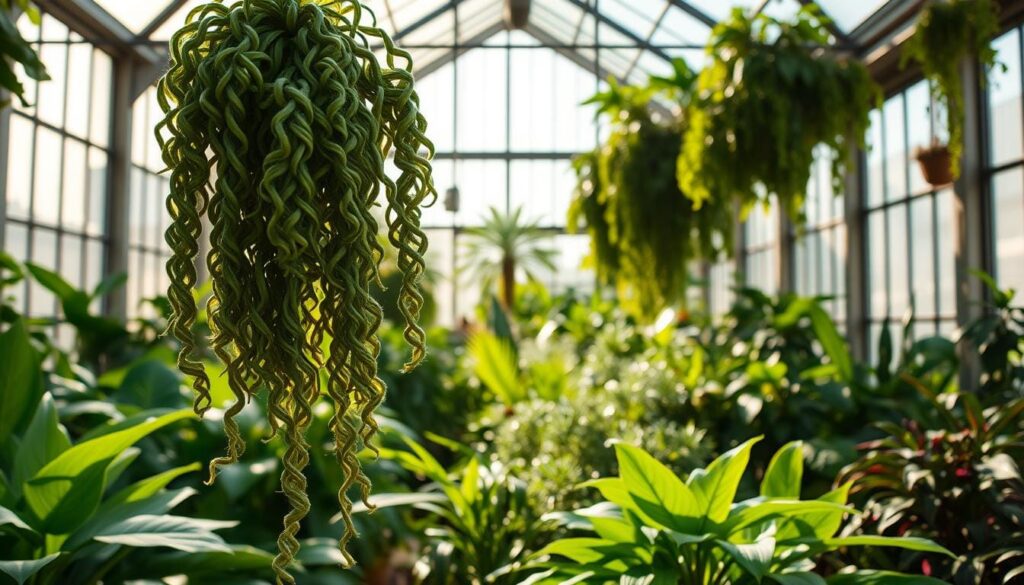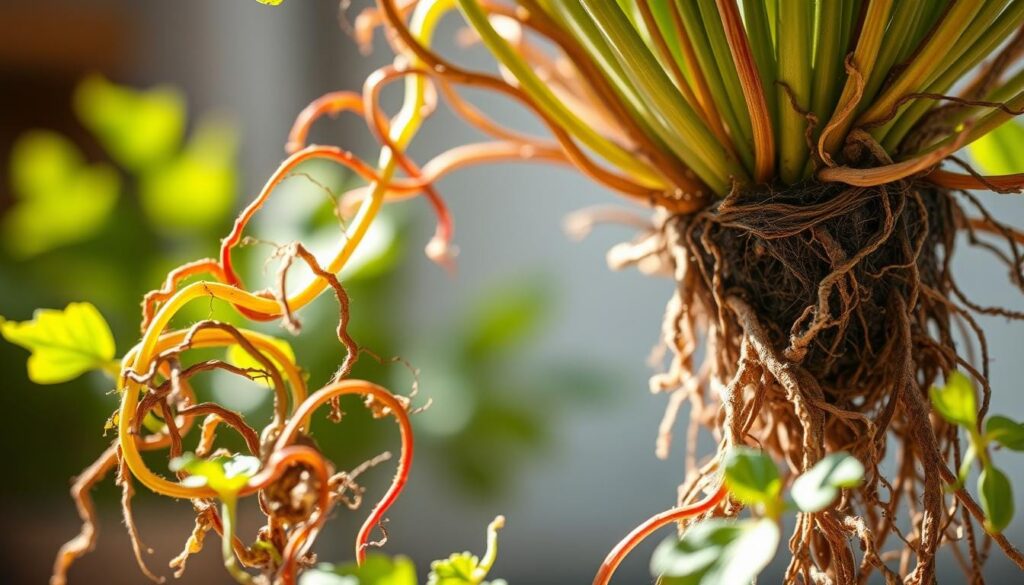Are you looking for a unique and visually striking houseplant to add some texture and interest to your indoor space? The curly hair plant, with its distinctive curly or spiral-shaped foliage, is an excellent choice. This visually appealing plant has gained popularity among indoor gardeners and collectors who appreciate its unusual appearance and relatively straightforward care requirements.
Whether you’re a novice or an experienced plant enthusiast, the curly hair plant is a great addition to your home. To achieve the best results today, it’s essential to understand the key care aspects, including light requirements, watering needs, and common issues. For a comprehensive guide on growing and caring for a similar plant, you can learn more about the Bonnie Curly Spider Plant, which shares similar care requirements.
Key Takeaways
- Understand the lighting needs for optimal growth
- Learn the proper watering schedule to avoid common issues
- Discover the best soil and fertilizer for your curly hair plant
- Find out how to propagate your plant effectively
- Explore tips for maintaining the plant’s unique appearance
Understanding the Curly Hair Plant
Understanding the Curly Hair Plant requires a closer look at its characteristics and growth habits. This plant is known for its unique curly hair or spiral-shaped foliage, which gives it a distinctive appearance.
What is a Curly Hair Plant?
The Curly Hair Plant is a species that has garnered attention for its curly hair-like leaves. It is a type of plant that exhibits a particular hair type characterized by its curled or spiraled shape. This unique characteristic sets it apart from other plants with different hair types.
Origin and Natural Habitat
The Curly Hair Plant originates from regions with specific climatic conditions that support its growth. Its natural habitat is characterized by certain levels of humidity and temperature, which contribute to its unique pattern of growth. The plant thrives in environments that mimic its natural conditions.
Unique Characteristics and Appearance
The Curly Hair Plant’s appearance is marked by its curly or spiral-shaped leaves, which can vary in color and texture. The plant’s overall shape and form are influenced by its growth pattern. As it matures, the plant can reach a certain height and spread, making it a visually appealing addition to any setting.
| Characteristics | Description |
|---|---|
| Foliage | Curly or spiral-shaped leaves |
| Growth Pattern | New leaves develop and unfurl in a unique pattern |
| Color Variations | Variations in leaf color add to the plant’s visual appeal |
| Mature Size | Potential height and spread when fully mature |
Ideal Growing Conditions

To thrive, the curly hair plant requires specific growing conditions that cater to its unique needs. Understanding these conditions is crucial for promoting healthy growth and maximizing its potential.
Light Requirements
The curly hair plant prefers bright, indirect light, making it an ideal choice for rooms with plenty of natural light but not direct sunlight, which can cause damage to its delicate follicles. East- or west-facing windows are perfect for providing the right amount of light. Avoid placing the plant in areas with low light, as this can lead to weak and sparse growth, potentially exacerbating hair loss issues in the plant’s appearance.
Temperature and Humidity Preferences
Maintaining the right temperature and humidity levels is vital for the curly hair plant. It thrives in temperatures between 65°F to 75°F (18°C to 24°C), which is typical for most indoor environments. However, it’s sensitive to extreme temperature fluctuations. High humidity, typically above 50%, is also preferred, mirroring its natural habitat. To achieve this, you can place the plant on a tray filled with water and pebbles or use a humidifier nearby.
Soil Type and Drainage Needs
The curly hair plant requires well-draining soil to prevent root rot, a condition that can arise from waterlogged soil. A mix specifically designed for tropical plants, with added perlite or sand, can enhance drainage. Ensuring the pot has adequate drainage holes is also crucial. This setup helps in maintaining healthy follicular units and promotes robust hair growth.
Container Selection
Choosing the right container is essential for the curly hair plant’s health. The container should be slightly larger than the plant’s root system, as this encourages growth without causing the soil to become too wet. Materials like terracotta or ceramic are preferable due to their breathability, which helps in maintaining optimal moisture levels. Ensure the container has good drainage holes to prevent water from accumulating, thus supporting healthy root development and overall plant well-being.
When selecting a container, consider both its functional and aesthetic qualities. A decorative pot that complements the plant’s unique appearance can enhance its visual appeal. As the plant grows, it may be necessary to repot it into a progressively larger container, a process similar to a hair transplant, where the plant is given more room to thrive.
Planting and Propagation Methods

To cultivate curly hair plants effectively, it’s crucial to master the techniques of planting and propagation. This involves understanding the different methods available and how to apply them successfully.
Starting from Seeds
Growing curly hair plants from seeds can be a rewarding experience. It requires careful preparation, including selecting high-quality seeds and providing the right conditions for germination. Seeds should be sown in a well-draining seed mix, and the soil should be kept consistently moist but not waterlogged. Optimal temperature and light conditions are crucial for successful germination.
Bulb Division Techniques
Bulb division is another effective method for propagating curly hair plants. This involves carefully separating the bulbs, making sure each section has at least one growing point. The divided bulbs should be replanted in a well-draining potting mix, and watered thoroughly. It’s essential to handle the bulbs gently to avoid damage and prevent transplant shock.
Transplanting Tips
Transplanting curly hair plants requires careful planning and execution. The best time to transplant is during the spring or fall when the plant is not under stress. Prepare the new container by filling it with a suitable potting mix, and handle the roots with care to minimize damage. After transplanting, ensure the plant receives adequate water and is placed in a suitable location with the right light conditions.
| Propagation Method | Key Considerations | Success Rate |
|---|---|---|
| Seeds | Soil quality, temperature, light | Moderate |
| Bulb Division | Handling, growing points, soil | High |
| Transplanting | Timing, soil preparation, handling | High |
By mastering these propagation methods, gardeners can successfully grow and maintain curly hair plants. Whether starting from seeds, dividing bulbs, or transplanting, each method has its unique benefits and challenges.
Proper Care and Maintenance

To keep your Curly Hair Plant healthy, it’s essential to understand its care and maintenance needs. Proper care involves a combination of appropriate watering, fertilization, pruning, and adjustments based on seasonal changes.
Watering Schedule
The Curly Hair Plant requires a consistent watering schedule. Water the plant when the top inch of soil feels dry to the touch, typically every 7-10 days, depending on the humidity and temperature of your environment. Overwatering can lead to root rot, while underwatering may cause the leaves to become dry and brittle.
Fertilization Guidelines
Fertilizing your Curly Hair Plant is crucial during its growing season, which typically spans from spring to early fall. Use a balanced, water-soluble fertilizer at half the recommended strength to avoid burning the roots. Fertilize every 4-6 weeks, as excessive fertilization can harm the plant.
Pruning and Grooming
Regular pruning is necessary to maintain the shape and promote healthy growth of the Curly Hair Plant. Remove any dead or damaged leaves, and trim back overgrown stems to encourage bushy growth. Pruning also helps in maintaining the plant’s curl pattern and overall appearance.
Seasonal Care Adjustments
Adjusting your care routine according to the season is vital for the well-being of your Curly Hair Plant. Here’s a summary of the seasonal adjustments you should make:
| Season | Watering | Fertilization | Pruning |
|---|---|---|---|
| Spring | Increase frequency as the plant starts growing | Resume fertilizing after the dormant winter period | Prune to shape and encourage new growth |
| Summer | Maintain regular watering, potentially more often in high temperatures | Continue fertilizing every 4-6 weeks | Regular grooming to maintain shape |
| Autumn/Fall | Gradually reduce watering as growth slows | Stop fertilizing as the plant prepares for dormancy | Minimal pruning, remove dead leaves |
| Winter | Reduce watering to once a month or less, depending on humidity | No fertilization during dormancy | No pruning, protect from drafts |
By following these care guidelines and making the necessary seasonal adjustments, you can ensure your Curly Hair Plant remains healthy and thrives throughout the year.
Common Problems and Solutions

While curly hair plants are relatively low-maintenance, they can still encounter several common problems. Understanding these issues and their solutions is crucial for maintaining a healthy and thriving plant.
Pest Identification and Control
One of the common issues with curly hair plants is pest infestation. Pests such as spider mites, mealybugs, and scale can cause significant damage. To control these pests, inspect your plant regularly and use insecticidal soap or neem oil as needed. Early detection is key to preventing widespread infestation.
For severe infestations, consider isolating the plant to prevent the pests from spreading to other plants. Regularly cleaning the leaves and ensuring good air circulation around the plant can also help prevent pest issues.
Disease Prevention and Treatment
Diseases such as root rot and leaf spot can affect curly hair plants. Root rot is often caused by overwatering, so ensuring the soil drains well and avoiding waterlogged conditions can help prevent it. If root rot occurs, repotting the plant in fresh, well-draining soil can be a solution.
Leaf spot diseases can be treated by removing affected leaves and improving air circulation around the plant. Fungicides may be necessary in severe cases. Maintaining good hygiene and removing any diseased foliage promptly can prevent the spread of disease.
Troubleshooting Growth Issues
Growth issues such as leggy growth, loss of curl pattern, or slow growth can be due to various factors including light, temperature, and fertilization. Ensuring the plant receives the right amount of light and maintaining an appropriate temperature can help.
For leggy growth, consider pruning the plant to encourage bushier growth. If the plant is losing its characteristic curl, adjusting the humidity or temperature may help. Regular fertilization with a balanced fertilizer can also promote healthy growth.
Conclusion
By understanding the specific needs and characteristics of the curly hair plant, gardeners can unlock its full potential and enjoy its beautiful, curly foliage. Throughout this article, we’ve explored the essential care requirements, including light, water, soil, and maintenance practices that contribute to the plant’s health.
The curly hair plant is a unique and fascinating addition to any indoor garden, offering a distinctive appeal that sets it apart from other plants. To successfully grow and maintain this plant, it’s crucial to apply the knowledge gained from this article to your own curly hair plant cultivation efforts.
We encourage you to experiment with different transplant methods to expand your collection or share with fellow plant enthusiasts. With patience and observation, you can overcome common challenges and enjoy the satisfaction of watching your curly hair plant thrive. For further guidance or community support, consider consulting resources dedicated to plant care and hair transplantation techniques.
By incorporating the curly hair plant into your home environment, you can enhance your indoor space with a touch of natural beauty and uniqueness. Happy gardening!

